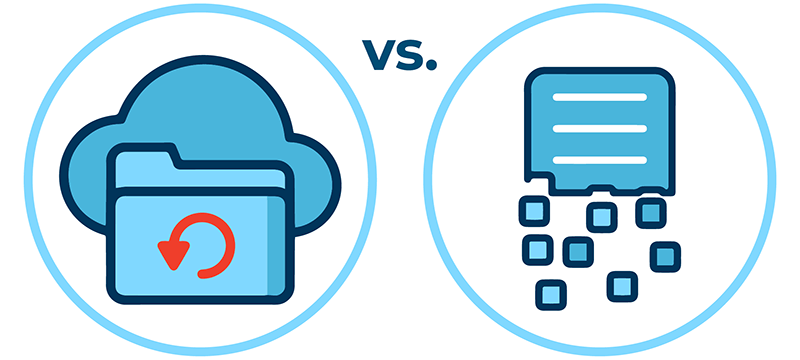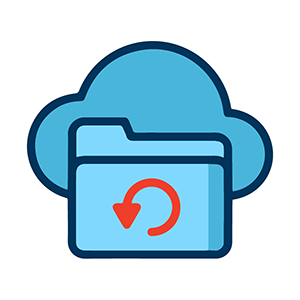
Have you ever been trying to understand the fine line between Data Loss Prevention (DLP) and backup solutions? Seeing them as two peas in a pod dedicated to safeguarding our precious data is expected. Yet, as we unravel their distinctive features, it becomes clear that they each have their turf, focus areas, and preferred moments to shine. In this exploration, we’re delving into the intricacies that set apart DLP from the realm of data backup. So, buckle up for a journey through the nuances of digital data security.

Data backup
In digital guardianship, data backup is the stalwart process of duplicating a data record and securely storing it on a separate remote medium. Data backup encompasses the arsenal of tools orchestrating this digital symphony.
The paramount goals of data backup are as follows:
- Data resurrection: A safety net to recover data in the face of loss.
- Legal armor: A measure to curtail legal repercussions.
- Downtime dilution: A strategy to minimize the disruption clock.
- Financial safeguard: A shield against monetary losses.
Within the intricate landscapes of IT environments, some abodes boasting copious data sets are endowed with innate data backup capabilities. Conversely, others in need of this digital armor beckon the embrace of either manual backup rituals or the aid of third-party tools.
Four archetypes of data backup emerge as the protagonists in this digital saga:
Mirror backup: Crafting a reflection sans the intricacies of data versions.
Incremental backup: A meticulous brushstroke capturing changes since the preceding backup.
Full backup: The maestro orchestrating a complete symphony of data duplication.
Differential backup: A daily diary chronicling changes since the last full backup.
The array of data backup tools, harnessing their digital prowess, brings many advantages that transcend the conventional manual chore of safeguarding information. Firstly, there is a remarkable reduction in the likelihood of errors, signifying a shift away from the intricate maze of potential mistakes inherent in manual processes. Secondly, valuable human resources are liberated as these tools free individuals from the constraints of monotonous and repetitive tasks. This boosts overall productivity and empowers skilled personnel to focus on more strategic aspects of data management. Lastly, deploying data backup tools introduces a seamless “Speed Symphony,” a rhythm that surpasses human capabilities. This agility ensures the swift execution of incremental or differential backups, enhancing overall efficiency and fortifying the defense against potential data vulnerabilities. Collectively, these advantages form a robust framework for modern data protection and management, showcasing the transformative impact of technological advancements in this crucial domain.
In the grand tapestry of digital defense, data backup emerges as the unsung hero, especially when the ominous specter of data loss looms large. It is the final bastion, an invincible guardian against the perils of a digital abyss.

Data loss prevention (DLP)
Data loss prevention (DLP) is a toolkit of strategic tools and practices carefully curated to prevent the loss and leakage of data within the complex realms of IT environments. Esteemed Software as a Service (SaaS) solutions like Google Workspace or Microsoft 365 come equipped with their own DLP features bolstered by various specialized tools available in the market.
Foundational objectives of DLP:
At its core, DLP is driven by several key goals:
1. Mitigating downtime from data loss
2. Safeguarding financial interests
3. Preventing data loss and leaks
4. Navigating legal implications
Complementary roles
Navigating the intricate landscape of data security tools, the pivotal question arises: Which should take precedence – data backup or DLP? The resounding answer echoes the need for both. With their distinctive focuses and purposes, the amalgamation of data backup and DLP emerges as a requisite for ensuring comprehensive data security within corporate realms.
A persistent query revolves around the efficacy of backups in fortifying data security, especially with our solution creating snapshots up to three times a day. Technically, companies are constrained to a single backup solution, presenting diverse challenges. In substantial data loss events, such as ransomware attacks or extensive editing, the recovery timeline can stretch over days or weeks, depending on the magnitude of data being restored. Moreover, the limitations of data backup become evident in its inability to address data leakage concerns, a void adeptly filled by the intervention of DLP.
Consider a scenario where an employee unwittingly becomes a pawn in a hacker’s scheme, leading to the unauthorized sharing of a coworker’s CCN. In such moments, DLP emerges as the vigilant guardian, thwarting potential breaches.
Amidst these considerations, another frequently posed question surfaces: “Why opt for data backup when DLP is in place?” The answer lies in the inherent limitations of DLP, which cannot offer absolute coverage for all incidents unless a stringent data modification environment is imposed, impeding everyday employee workflows. Consequently, no DLP solution can boast a foolproof prevention of 100% of incidents. A tangible illustration accentuates this point, involving an employee crafting a critical reporting file on their cloud drive, essential for the monthly workings of their team. As the employee departs, their cloud account and associated data vanish. The team, realizing the document’s absence at month-end, turns to backup for retrieval, subsequently relocating it to a shared drive to forestall similar oversights in the future.
💡Learn more about Hystax Acura Cloud Backup software that enables you to replicate and restore data in a fully-automated way in case of disasters, virus attacks, or any software and hardware failures → https://hystax.com/hystax-acura-cloud-backup/



